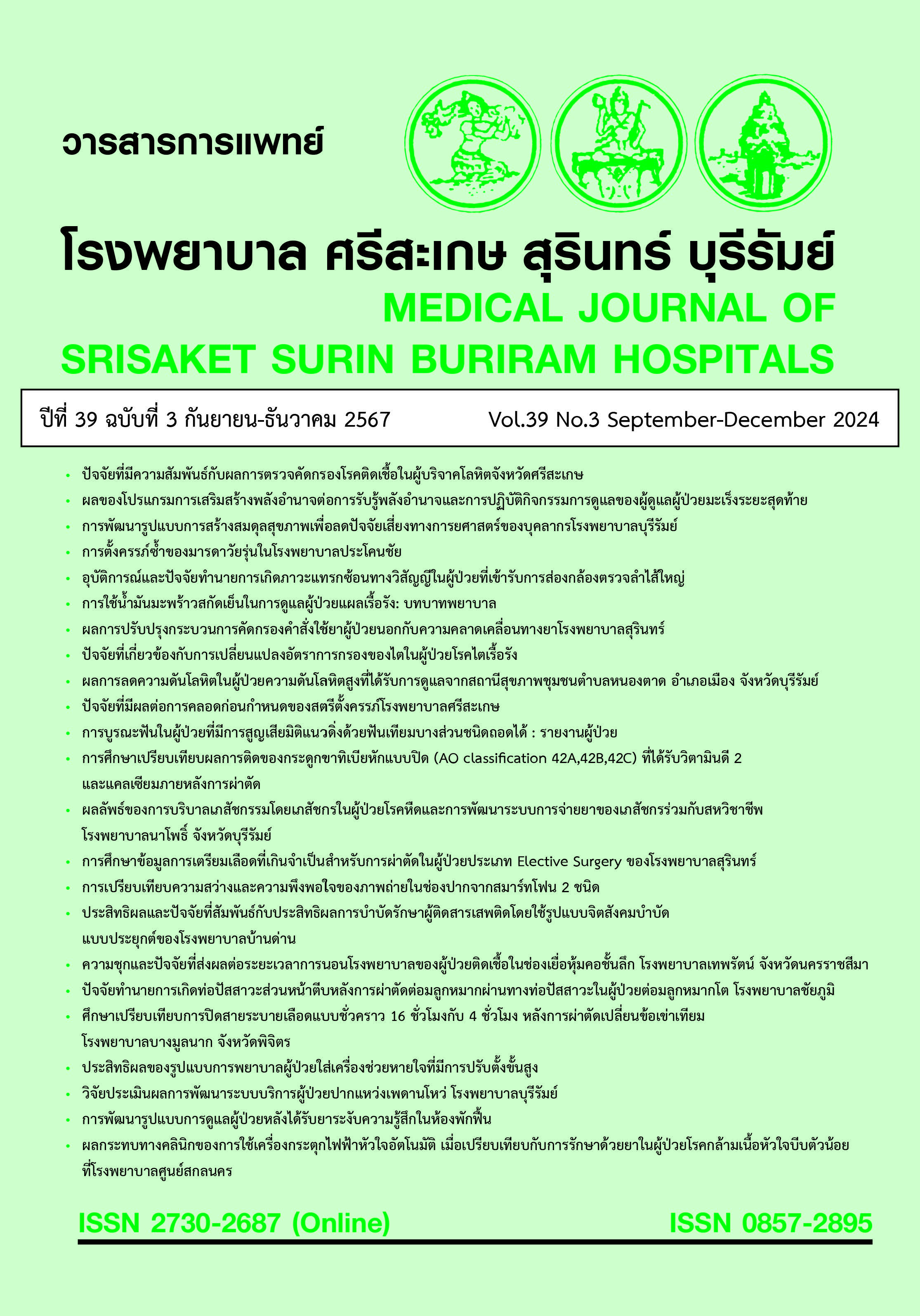การศึกษาเปรียบเทียบผลการติดของกระดูกขาทิเบียหักแบบปิด (AO classification 42A,42B,42C) ที่ได้รับวิตามินดี 2 และ แคลเซียม ภายหลังการผ่าตัด
Main Article Content
บทคัดย่อ
หลักการและเหตุผล: การให้วิตามินดี และ แคลเซี่ยมภายหลังกระดูกหักช่วยให้กระดูกติดดีขึ้น ในผู้ป่วย osteoporosis แต่ยังเป็นข้อถกเถียงในผู้ป่วยที่มีกระดูกขาทิเบียหักแบบปิด ว่าสามารถทำให้การติดของกระดูกดีขึ้นหรือไม่ เมื่อได้รับวิตามินดี2 และแคลเซี่ยมภายหลังผ่าตัด
วัตถุประสงค์: เพื่อหาว่าการให้วิตามินดี2 และ แคลเซี่ยมในผู้ป่วยกระดูกขาทิเบียหักแบบปิด สามารถเพิ่มอัตราการติดของกระดูกได้หรือไม่ เมื่อเทียบกับผู้ป่วยที่ไม่ได้รับ
วิธีการศึกษา: เป็นการวิจัยศึกษาแบบย้อนหลังโดยการทบทวนเวชระเบียนผู้ป่วยกระดูกขาทิเบียหักที่ได้รับการรักษาที่โรงพยาบาลสุรินทร์ ตั้งแต่ 1 มกราคม พ.ศ. 2555 - 30 พฤศจิกายน พ.ศ. 2566 โดยเปรียบเทียบอัตราการติดของกระดูกระหว่างผู้ป่วยที่ไม่ได้รับวิตามินดี 2 (group 1) กับ ผู้ป่วยที่ได้รับวิตามินดี 2 และ แคลเซี่ยม 1,000 มิลิกรัม (group 2) ภายหลังการผ่าตัดดามกระดูก
ผลการศึกษา: ได้กลุ่มตัวอย่างทั้งหมด 202 คน โดยแบ่งเป็น 119 คน, 83 คน ในกลุ่ม 1 และ กลุ่ม 2 ตามลำดับ พบอัตราการติดของกระดูก ดังนี้ ร้อยละ 85.7 84.3 p=0.79 ซึ่งไม่มีนัยสำคัญทางสถิติ
สรุป: ผู้ป่วยกระดูกขาทิเบียหักแบบปิด ที่ได้รับการผ่าตัดดามกระดูกที่ได้รับวิตามินดี 2 และ แคลเซี่ยม ภายหลังผ่าตัด พบว่าอัตราการติดของกระดูก ไม่มีความแตกต่างกันทางสถิติ
Article Details

อนุญาตภายใต้เงื่อนไข Creative Commons Attribution-NonCommercial-NoDerivatives 4.0 International License.
เอกสารอ้างอิง
Omeroğlu H, Ateş Y, Akkuş O, Korkusuz F, Biçimoğlu A, Akkaş N. Biomechanical analysis of the effects of single high-dose vitamin D3 on fracture healing in a healthy rabbit model. Arch Orthop Trauma Surg 1997;116(5):271-4. doi: 10.1007/BF00390051.
Delgado-Martínez AD, Martínez ME, Carrascal MT, Rodríguez-Avial M, Munuera L. Effect of 25-OH-vitamin D on fracture healing in elderly rats. J Orthop Res 1998;16(6):650-3. doi: 10.1002/jor.1100160604.
Brumbaugh PF, Speer DP, Pitt MJ. 1 alpha, 25-Dihydroxyvitamin D3 a metabolite of vitamin D that promotes bone repair. Am J Pathol 1982;106(2):171-9. PMID: 6895976
Doetsch AM, Faber J, Lynnerup N, Wätjen I, Bliddal H, Danneskiold-Samsøe B. The effect of calcium and vitamin D3 supplementation on the healing of the proximal humerus fracture: a randomized placebo-controlled study. Calcif Tissue Int 2004;75(3):183-8.
doi: 10.1007/s00223-004-0167-0.
Haines N, Kempton LB, Seymour RB, Bosse MJ, Churchill C, Hand K, et al. The effect of a single early high-dose vitamin D supplement on fracture union in patients with hypovitaminosis D: a prospective randomised trial. Bone Joint J 2017;99-B(11):1520-5. doi: 10.1302/0301-620X.99B11.BJJ-2017-0271.R1.
Sprague S, Petrisor B, Scott T, Devji T, Phillips M, Spurr H, et al. What Is the Role of Vitamin D Supplementation in Acute Fracture Patients? A Systematic Review and Meta-Analysis of the Prevalence of Hypovitaminosis D and Supplementation Efficacy. J Orthop Trauma 2016;30(2):53-63. doi: 10.1097/BOT.0000000000000455.
Gorter EA, Krijnen P, Schipper IB. Vitamin D status and adult fracture healing. J Clin Orthop Trauma 2017;8(1):34-37. doi: 10.1016/j.jcot.2016.09.003.
Hood MA, Murtha YM, Della Rocca GJ, Stannard JP, Volgas DA, Crist BD. Prevalence of Low Vitamin D Levels in Patients With Orthopedic Trauma. Am J Orthop (Belle Mead NJ) 2016;45(7):E522-E526. PMID: 28005107.
Ettehad H, Mirbolook A, Mohammadi F, Mousavi M, Ebrahimi H, Shirangi A. Changes in the serum level of vitamin d during healing of tibial and femoral shaft fractures. Trauma Mon 2014;19(1):e10946. doi: 10.5812/traumamon.10946.
Slobogean GP, Bzovsky S, O'Hara NN, Marchand LS, Hannan ZD, Demyanovich HK, et al. Effect of Vitamin D3 Supplementation on Acute Fracture Healing: A Phase II Screening Randomized Double-Blind Controlled Trial. JBMR Plus 2022;7(1):e10705.
doi: 10.1002/jbm4.10705.
Phieffer LS, Goulet JA. Delayed unions of the tibia. J Bone Joint Surg Am 2006;88(1):206-16. doi: 10.2106/00004623-200601000-00026.
Zura R, Xiong Z, Einhorn T, Watson JT, Ostrum RF, Prayson MJ, et al. Epidemiology of Fracture Nonunion in 18 Human Bones. JAMA Surg 2016;151(11):e162775. doi: 10.1001/jamasurg.2016.2775.
Tian R, Zheng F, Zhao W, Zhang Y, Yuan J, Zhang B, et al. Prevalence and influencing factors of nonunion in patients with tibial fracture: systematic review and meta-analysis. J Orthop Surg Res 2020;15(1):377. doi: 10.1186/s13018-020-01904-2.
Rosner B. Fundamentals of Biostatistics. 5th. ed. Stamford : Duxbury Thomson Learning ; 2000 : 384-5.
Fleiss JL, Levin B, Paik MC. Statistical methods for rates and proportions. 3rd.ed. Philadephia : John Wiley & Sons, Inc. ; 2003 : 76.
Ngamjarus C, Chongsuvivatwong V, McNeil E. n4Studies: Sample Size Calculation for an Epide-miological Study on a Smart Device. Siriraj Med J 2016;68(3):160-70.
Morshed S. Current Options for Determining Fracture Union. Adv Med 2014;2014:708574. doi: 10.1155/2014/708574.
Whelan DB, Bhandari M, McKee MD, Guyatt GH, Kreder HJ, Stephen D, et al. Interobserver and intraobserver variation in the assessment of the healing of tibial fractures after intramedullary fixation. J Bone Joint Surg Br 2002;84(1):15-8. doi:
1302/0301-620x.84b1.11347.
Kooistra BW, Dijkman BG, Busse JW, Sprague S, Schemitsch EH, Bhandari M. The radiographic union scale in tibial fractures: reliability and validity. J Orthop Trauma 2010;24 Suppl 1:S81-6. doi: 10.1097/BOT.0b013e3181ca3fd1.
Doshi P, Gopalan H, Sprague S, Pradhan C, Kulkarni S, Bhandari M. Incidence of infection following internal fixation of open and closed tibia fractures in India (INFINITI): a multi-centre observational cohort study. BMC Musculoskelet Disord 2017;18(1):156. doi: 10.1186/s12891-017-1506-4.


